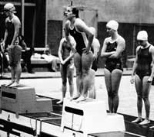Three of the MIT swim records Professor Karen Klincewicz Gleason (SB and SM, 1982) set her sophomore year stood for 20 years until freshman Georgene Hilb finally broke them this season.
Ms. Hilb swam the 1,000-yard freestyle in 10:53.69 in a victory over Babson and Bowdoin Colleges in December, beating the Karen Klincewicz record by 2.31 seconds. In February, she swam the 500-yard freestyle in 5:13.33 in a match against Tufts; Ms. Klincewicz swam it in 5:16.72 in 1980. Ms. Hilb also broke Ms. Klincewicz's record in the 1,650-yard (the swimmer's mile) freestyle by 13 seconds (18:24.27) earlier this year.
Professor (Klincewicz) Gleason's former swim coach, John Benedick (now MIT's assistant director of athletics), sent her an e-mail informing her that her record had fallen.
"I flashed back to that time," said Professor Gleason of chemical engineering. "It didn't seem like that big a deal then; I didn't expect it to last this long. But it's been more than 20 years, so it's good that it was broken. And Georgene has a couple of years left to break more records."
Ms. Hilb hopes to do just that. A competitive young woman, she checked out the MIT records soon after arriving and was ready to take them on.
"It was a conscious effort. My personal record in the 500 was 5:13 and hers was 5:16, so I thought I would break that one," said Ms. Hilb. "All the oldest records still standing were hers."
When she graduated in 1982, Karen Klincewicz (pronounced "klin-SHEV-itz") held MIT records in 11 individual events and five relays. Even now, she has one record standing -- the 200-yard individual medley or IM (50 yards each of butterfly, back stroke, breast stroke and freestyle) set in 1980 at 2:14.6.
Ms. Hilb may take on the 200 IM record next year. She has already beaten MIT's record for the 400 IM, but Karen Klincewicz no longer held it at that point.
KAREN GLEASON
Professor Gleason graduated from MIT with both a bachelor's degree in chemistry and a master's degree in chemical engineering in 1982. She earned the PhD from the University of California at Berkeley and returned to MIT in 1987 as an assistant professor, the first woman appointed to the chemical engineering department. She has been named executive officer (second in command) for the department beinning in July.
She still swims competitively on a master's team at Harvard. She and her husband Edward Gleason, a chemical engineer who works in private industry, work out three or four days a week with that team ("he's more enthusiastic, which is good for me," she said). Though her enthusiasm may wane occasionally, one couldn't tell it from hearing her talk about swimming, especially the butterfly.
"I hope I'm still doing butterfly when I'm 80," she said. "It's got that dolphin motion that just feels great. It's like flying."
Professor Gleason said she thinks she can still swim the 500-yard freestyle in under six minutes, but seems a little embarrassed that she can't do it in 5:16 anymore.
2001 TEAM
This year, the women's and men's swim teams, coached by Mary Ellen McLaughlin, finished second in their conference (the NEWMAC: New England Women's and Men's Athletic Conference). The women's team ended its season in a tie with last year's best-ever record of eight wins to one loss, beaten only by Wellesley. Ms. Hilb was named the NEWMAC Swimmer of the Year.
Ms. Hilb went to DuPont High School in Louisville, KY, and has been swimming competively since age nine. She isn't much into "land sports," she said. But she did run the Boston Marathon with some other swimmers, making the decision after spring break and training for the 26.2-mile-race with four runs. She completed the marathon in four hours, 38 minutes.
"I'm not a runner," she said, which ought to make all the people who actually trained for the marathon and ran it in five hours or more wonder if they might be swimmers instead.
A version of this article appeared in MIT Tech Talk on May 9, 2001.









